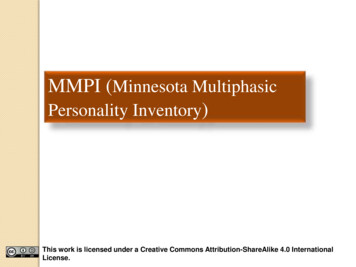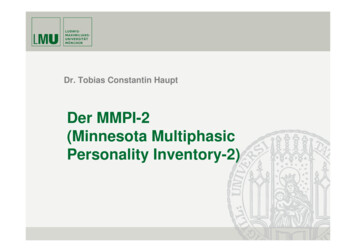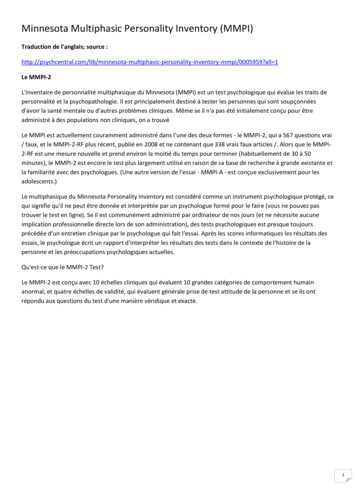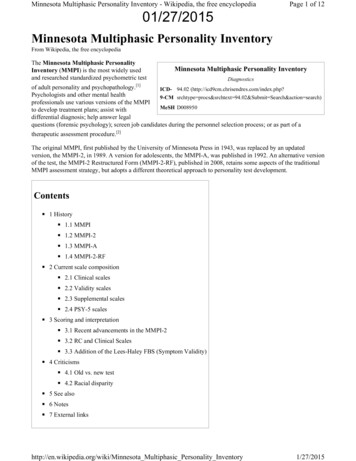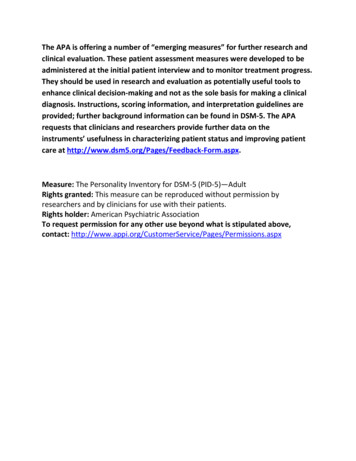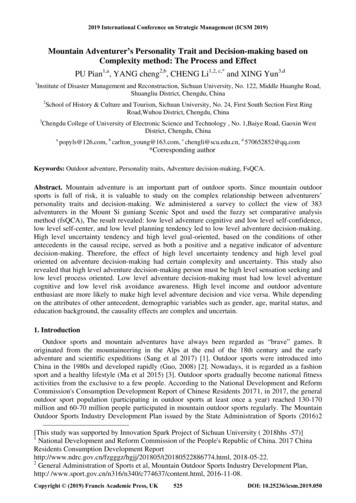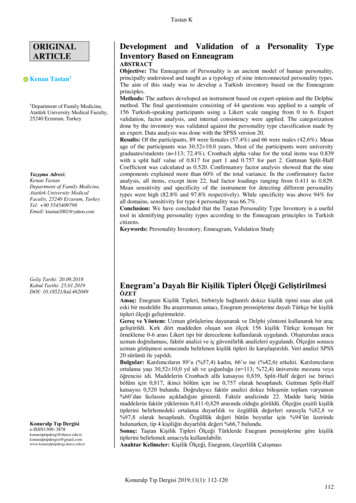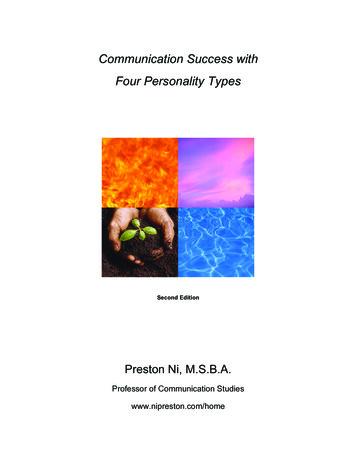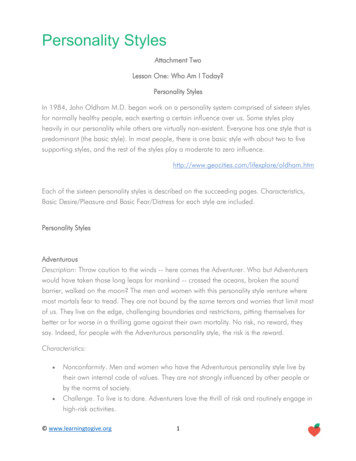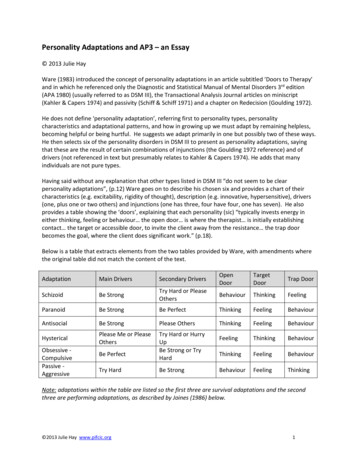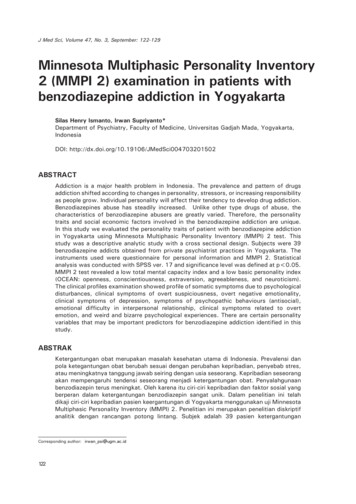
Transcription
J Med Sci, Volume 47, No. 3, September: 122-129Minnesota Multiphasic Personality Inventory2 (MMPI 2) examination in patients withbenzodiazepine addiction in YogyakartaSilas Henry Ismanto, Irwan Supriyanto*Department of Psychiatry, Faculty of Medicine, Universitas Gadjah Mada, Yogyakarta,IndonesiaDOI: RACTAddiction is a major health problem in Indonesia. The prevalence and pattern of drugsaddiction shifted according to changes in personality, stressors, or increasing responsibilityas people grow. Individual personality will affect their tendency to develop drug addiction.Benzodiazepines abuse has steadily increased. Unlike other type drugs of abuse, thecharacteristics of benzodiazepine abusers are greatly varied. Therefore, the personalitytraits and social economic factors involved in the benzodiazepine addiction are unique.In this study we evaluated the personality traits of patient with benzodiazepine addictionin Yogyakarta using Minnesota Multiphasic Personality Inventory (MMPI) 2 test. Thisstudy was a descriptive analytic study with a cross sectional design. Subjects were 39benzodiazepine addicts obtained from private psychiatrist practices in Yogyakarta. Theinstruments used were questionnaire for personal information and MMPI 2. Statisticalanalysis was conducted with SPSS ver. 17 and significance level was defined at p 0.05.MMPI 2 test revealed a low total mental capacity index and a low basic personality index(OCEAN: openness, conscientiousness, extraversion, agreeableness, and neuroticism).The clinical profiles examination showed profile of somatic symptoms due to psychologicaldisturbances, clinical symptoms of overt suspiciousness, overt negative emotionality,clinical symptoms of depression, symptoms of psychopathic behaviours (antisocial),emotional difficulty in interpersonal relationship, clinical symptoms related to overtemotion, and weird and bizarre psychological experiences. There are certain personalityvariables that may be important predictors for benzodiazepine addiction identified in thisstudy.ABSTRAKKetergantungan obat merupakan masalah kesehatan utama di Indonesia. Prevalensi danpola ketegantungan obat berubah sesuai dengan perubahan kepribadian, penyebab stres,atau meningkatnya tanggung jawab seiring dengan usia seseorang. Kepribadian seseorangakan mempengaruhi tendensi seseorang menjadi ketergantungan obat. Penyalahgunaanbenzodiazepin terus meningkat. Oleh karena itu ciri-ciri kepribadian dan faktor sosial yangberperan dalam ketergantungan benzodiazepin sangat unik. Dalam penelitian ini telahdikaji ciri-ciri kepribadian pasien keergantungan di Yogyakarta menggunakan uji MinnesotaMultiphasic Personality Inventory (MMPI) 2. Penelitian ini merupakan penelitian diskriptifanalitik dengan rancangan potong lintang. Subjek adalah 39 pasien ketergantunganCorresponding author: irwan psi@ugm.ac.id122
Ismanto & Supriyanto, Minnesota Multiphasic Personality Inventory 2 (MMPI 2)examination in patients with benzodiazepine addiction in Yogyakartabenzodiazepine dari praktek dokter di Yogyakarta. Instrumen yang digunakan adalahkuesioner untuk informasi individu dan MMPI 2. Analisis statistik menggunakan SPSSversi 17 dengan tingkat kepercayaan p 0,05. Uji MMPI 2 diperoleh indeks kapasitasmental total rendah dan indeks personal dasar rendah (OCEAN: keterbukaan, kesadaran,ekstravet, keramahtamahan dan neurotisisme. Pemeriksaan klinik menunjukkan adanyagambaran gejala somatik karena gangguan psikologi, gambaran klinik kecurigaan yangberlebihan, emosi negatif yang berlebihan, gejala klinik depresi, gejala klinik yang berkaitandengan emosi yang berlebihan, dan pengalaman psikologi yang aneh-aneh. Terdapatbeberapa jenis kepribadian tertentu yang mungkin bias digunakan sebagai prediktorketergantungan benzodiazepine yang diperoleh dalam penelitian ini.Keywords: addiction – benzodiazepine – personality – MMPI 2 – drug ubuseINTRODUCTIONSubstance abuse is worldwide problems.The major drugs of abuse were heroin,cocaine, LSD, and amphetamine.1 Substanceabuse leads to drug addiction, a chronicneurobiological condition characterized bycompulsion to seek and use a substance, loss ofcontrolover consumption, and the emergenceof a negative emotional state when access tothe substance is prevented.2,3 The prevalenceand pattern of drugs addition seems to haveshifted according to changes in personality,life circumstances, or increasing levels ofresponsibility as people grow.2 Economicuncertainty, socialdislocation, isolation, andinequalities are modern stressful stimuli thatpose the risk of addiction. Stress systemsgreatlycontribute to the addiction cycleof drugcraving and withdrawal, pushingtheaddicted individual toward compulsivedrugtaking.4 How people adapt and adjust tostressors is affected by individual personality,which might affect their tendency to developdrug addiction.Personality is an important componentfor the management of addiction. Cognitivebehaviour approaches are grounded in sociallearning theoriesand principles of operantconditioning. The efficacy this approach ishighly affected by personality and adaptivecoping skills. People with better coping skillswill have better control of their behaviourand can effectively employ these strategies.5Addiction to illicit drugs remains a clinicaland social problem, in part owing to the lack ofeffective treatment. The challenges of copingwith addiction extend to the bench, pullingresearchers to continue exploring the originsof addiction and the molecular and structuralchanges in the brain driving lack of self-controland impulsivity in people suffering fromaddiction or relapses. Researchers are alsoseeking to what they called endophenotypes,individual characteristics that inclineindividuals toward addictions, includingpersonality traits.6 Personality traits arethought to be responsible for the developmentand addiction. The partial heritability of thesepersonality traits might also responsible forthe heritability of addiction.7,8Addiction potential is defined by beliefsand attitudes towards drug use and perceptionof related consequences as either negative orpositive. The tendency to use drugs is directlyrelated to the attitudes of individuals regardingthe legality and the scale of social acceptanceof drugs, the harm resulting from drug use,or the pleasant consequences of using drugs.These factors are pre-determined particularly123
J Med Sci, Volume 47, No. 3, September: 122-129by personality traits.9 MMPI (MinnesotaMultiphasic Personality Inventory) can beused to assess the presence of personalitytraits vulnerable to addiction. The five factormodel for basic personality profile measuredwith MMPI fits well with the measurementrequired to assess and predict addiction.10Benzodiazepine has become popular drugsof abuse, partly due to its cheap price. Theprevalence of benzodiazepine abuse, basedon visits to psychiatrist in Yogyakarta, isincreasing. Unlike other type drugs of abuse, thedemographic characteristic of benzodiazepineabusers is greatly varied. Therefore, unlikeother drugs of abuse, the personality traitsand social economic factors involved in thedevelopment of benzodiazepine addiction aresomewhat unique. Understanding these uniquecharacteristics is an important determinantto better treat patients with benzodiazepineaddition. The use of benzodiazepine torelieve withdrawal symptoms significantlycontributes to the increased prevalenceof benzodiazepine addiction. Patients onmethadone maintenance therapy often reportfrequent use of benzodiazepine. Based onabove explanation, it is clear how personalityhave impacts on the tendency to developaddiction and the efficacy of approachesto manage addiction. Therefore, in thisstudy we examined the association betweenpersonality profiles based on MMPI 2 test andbenzodiazepine addiction.MATERIALS AND METHODSStudy DesignThis study is a descriptive analytic studywith a cross sectional design. After the subjectis diagnosed as addicted to benzodiazepine,MMPI 2 profile is then checked for eachsubject.124Study SubjectsThe subjects of this study were patientswho chronically abused benzodiazepinein Yogyakarta. Subjects were obtainedfrom psychiatrist practice in Yogyakarta.The reason we use private practice is thatmost of drug abusers refrained from visitinghospitals or clinics. They feel safer to visitprivate practice. By using private practice, wereduced the level of psychological stressorsthe subjects have to face due to fears of beingwatch by the authority, being arrest by thepolice. The inclusion criteria were diagnosedas having benzodiazepine addiction by at leasttwo psychiatrists, provide informed consent,and age between 20-40 years old. Subjectswith severe mental disorders and those whodid not complete the MMPI test and/or thequestionnaire were excluded from this study.Subjects were randomly selected by usingclustered simple random sampling.InstrumentsInstruments used in this study wereinformed consent and subjects informationforms; questionnaire for personal anddemographics information; and MMPI 2Indonesian version.Data analysisDistribution of demographic characteristicswill be presented as frequency tables.TheMMPI 2 test results will be descriptivelypresented as parameters. T score will beanalyzed with correlation analysis withdemographic characteristics using SPSS ver.17 software. Level of significance was definedat p 0.05.RESULTSIn our study, 39 subjects were includedwhich almost all were male (97.4%). The
Ismanto & Supriyanto, Minnesota Multiphasic Personality Inventory 2 (MMPI 2)examination in patients with benzodiazepine addiction in Yogyakartaaverage age was 33.3 6.7 years old. Morethan half of our subjects (66.7%) were married.Most of the subjects were highly educated(82.0%), graduated from high school or higher.To our surprise, only 1 subjects (2.6%) whowere unemployed and more than half (51.3%)had income higher than minimum provincialwage (TABLE 1).Most of our subjects weresmoking (89.7%) and consumed alcohol(56.4%). Most of our subject claimed that theyhave benzodiazepine addiction for more than3 years (82.1%). A number of 7 subjects (17.9)had been admitted to hospital previously dueto addiction related problems. Most of oursubjects (92.3%) had also attempted to stoptheir addiction but failed (TABLE 2).TABLE 1. Demographic characteristicsVariablesSexMaleFemaleAge (years)33.3 6.7Marital status SingleMarriedEducationElementaryJunior highSenior highCollege degreeOccupationCivil servantPrivateSelf employedLaborMerchantOthersUnemployedIncome minimumprovincial wage minimumprovincial 364.117.92.638.628.220.52.67.72.651.31948.7TABLE 2. Characteristics of patients withbenzodiazepine addictionVariablesSmoking habitAlcohol consumptionDuration of addictionHistory of hospitalizationdue addiction problemsAttempts to stopYesNoYesNo 3 years 3 7.982.1YesNo36392.37.7MMPI 2 results for mental capacityindex revealed that our subjects had low totalmental capacity index (4.32 1.26). Thescore for performance potential, aviour, and mental capacity index werealso low (TABLE 3). Basic personality index(OCEAN score) showed that our subjects hadlow OCEAN score for every sub categories(openness, conscientiousness, extraversion,agreeableness, and neuroticism) as shown inTABLE 4TABLE 3. Mental capacity index based on MMPI 2VariablesPerformance potentialAdaptabilityPsychological constraintRisk taking behaviorMoral integrityMental capacity indexMean0.191.011.130.791.204.32 SD0.330.410.440.410.251.26Tabel 4. OCEAN score based on MMPI 2 versionAgreeablenessNeuroticismMean SD4.5 2.30.2 0.51.4 0.61.1 0.71.1 0.60.6 1.5125
J Med Sci, Volume 47, No. 3, September: 122-129related to overt emotion, and weird andbizarre experience psychological experiences(TABLE 5). We conducted Mann Whitney teston the basic personality index and OCEANscore. We found that education level wassignificantly associated with performancepotential and risk taking behaviours (TABLE6 and 7).The clinical profiles examination showedthat our subjects showed somatic symptomsdue to psychological disturbances, clinicalsymptoms of overt suspiciousness, overtnegative emotionality, clinical symptomsof depression, symptoms of psychopathicbehaviours (antisocial), emotional difficulty ininterpersonal relationship, clinical symptomsTABLE 5. Clinical profiles of the subjects based on MMPI 2 examinationClinical profilesSomatic symptoms due to psychological disturbancesClinical symptoms of overt suspiciousnessOvert negative emotionalityClinical symptoms of depressionSymptoms of psychopathic behaviours (antisocial)Emotional difficulty in interpersonal relationshipClinical symptoms related to overt emotionWeird and bizarre experience psychological experiencesN %34 87.236 92.329 74.44 10.38 20.58 20.55 12.838 97.4TABLE 6. Mann Whitney test of the Mental capacity index scores to other PsychologicalconstraintRisk taking behaviourMoral integrityMentalcapacityindexZpZpZpZPZpZpMarital -0.6130.5400.2740.799Education 2.0830.037-1.5960.110-0.1530.878-1.1520.249Smoking 0.7810.435-1.0650.287Alcohol 1740.240Stop 26-1.1190.263-0.7380.460TABLE 7. Mann Whitney test of the OCEAN scores to other roticismZOCEANZpZZpZppZMarital status-1.9140.056-0.7890.425-0.4740.635-0.
instruments used were questionnaire for personal information and MMPI 2. Statistical analysis was conducted with SPSS ver. 17 and significance level was defined at p 0.05. MMPI 2 test revealed a low total mental capacity index and a low basic personality index (OCEAN: openness, conscientiousness, extraversion, agreeableness, and neuroticism). The clinical profiles examination showed profile of .
